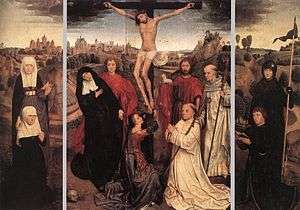Women at the crucifixion
The presence of a group of female disciples of Jesus at the crucifixion of Jesus is found in all four Gospels of the New Testament. There have been different interpretations of how many and which women were present.
The New Testament accounts

| Matthew | Mark | Luke | John |
|---|---|---|---|
| Women at the cross | |||
| many women ... who had followed Jesus from Galilee, ministering to him, among whom were Mary Magdalene and Mary the mother of James and Joseph and the mother of the sons of Zebedee 27:55-56 | women ... among whom were Mary Magdalene, and Mary the mother of James the younger and of Joses, and Salome 15:40 | the women who had followed him from Galilee 23:49 | his mother and his mother's sister, Mary the wife of Clopas, and Mary Magdalene 19:25 |
| Women who accompanied the body to the tomb | |||
| Mary Magdalene and the other Mary were there, sitting opposite the tomb 27:61 | Mary Magdalene and Mary of Joses saw where he was laid 15:47 | the women who had come with him from Galilee 23:55 | |
| Women who go to the tomb after the Sabbath at dawn | |||
| Mary Magdalene and the other Mary 28:1 | Mary Magdalene and Mary the mother of James and Salome 16:1 | Mary Magdalene and Joanna and Mary the mother of James and the other women with them 24:10 | Mary Magdalene 20:1 |
Interpretations
Matthew and Mark, who speak of "many women" present at the crucifixion, mention three individually at the death of Jesus and two at his burial. Matthew describes the third individual present at the death as the mother of the sons of Zebedee, without naming her. Mark's third individual is called Salome. Luke mentions none individually. John mentions four individually, including Jesus' mother Mary, who is not mentioned by the other evangelists.
The indication in John 19:25 could be interpreted as referring to two, three or four women. There are difficulties against taking it as presenting a double apposition, with "his mother" being Mary of Clopas, and "his mother's sister" being Mary Magdalene. If the women are three, then there is a single apposition, with Mary of Clopas presented as the sister of Jesus' mother (despite the awkwardness of having two sisters bearing the same name) or else, since Hebrew and Aramaic had no specific word for "cousin", presented as her cousin or her sister-in-law, with Clopas considered the brother of Joseph. If there is no apposition, the women are four, as understood by Tatian and the Peshitta.[1] If the last interpretation is chosen, the accounts that the four evangelists give of individual women present at the crucifixion are:
| Matthew | Mark | Luke | John |
|---|---|---|---|
| Mary, mother of Jesus | |||
| Mary Magdalene | Mary Magdalene | Mary Magdalene | |
| Mary, mother of James and Joseph | Mary, mother of James the younger and Joses | ||
| The mother of the sons of Zebedee | |||
| Salome | |||
| A sister of Mary, mother of Jesus | |||
| Mary of Clopas |
Mary Magdalene is mentioned by all the evangelists apart from Luke, who mentions no individual. Mary, mother of James and Joseph/Joses is mentioned by Matthew and Mark. The others are mentioned by one evangelist only: Mary, the mother of Jesus; Mary, the mother of the sons of Zebedee; Salome; a sister of Mary, mother of Jesus; Mary of Clopas. Attempts have been made to consider all these, except Mary, the mother of Jesus, as different designations of the same woman.
Thus Salome has been supposed to be the same as Mary of Clopas and to have been the mother of Zebedee's sons James and John, and a half-sister or sister-in-law of Mary the mother of Jesus.[2] See The Three Marys#The three daughters of Saint Anne.
References
- ↑ Raymond E. Brown, The Death of the Messiah (Chapman 1994 ISBN 0-225-66748-7), pp. 1014-1015
- ↑ Adam Clarke, The Holy Bible, containing the Old and New Testaments, Volume 3 1837- Page 794: "That Cleophas, called also Alpheus, married a sister of the blessed virgin, called also Mary, by whom he had the above issue ; and that ... among whom were Mary Magdalen, and Mary the mother of James the less and of Joses, and Salome was"